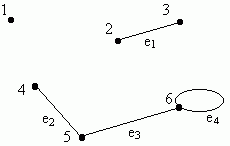
Paths, Circuits, and Cycles
A path is a list of vertices in a graph, directed graph, or weighted graph. For each adjacent pair on the list, that corresponding edge must be in the graph. The length of a path in a graph or directed graph is the number of edges in the path. For example, consider this graph:

The sequence 4 → 5 → 6 is a path of length 2, while the sequence 1 → 2 → 3 is not a path. There is no path from 1 to 6. In the following directed graph
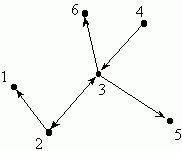
The sequence 4 → 3 → 2 → 1 is a path of length 3, while 5 → 3 → 2 → 1 is not a path.
In a weighted graph, the length of a path is the sum of the weight of each of its edges. In the following weighted graph,
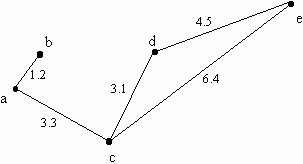
the path b → a → c → d → e has total weight 1.2 + 3.3 + 3.1 + 4.5 = 12.1. It is not the shortest path from b to e, since the path b →a → c → e has total weight 1.2+3.3+6.4 = 10.9. (Note that some textbooks use the word trail for what we have just described, and reserve the word path for trails in which no edge appears more than once.) A circuit is a path that starts and ends at the same vertex. A cycle is a circuit that does not repeat any edges. For example, in the weighted graph above, c → d → e → c is a cycle.
Connectedness
A graph is connected if for each pair of vertices a and b, there is a path in the graph starting at a and ending at b. The graph at the top of this page is not connected. The weighted graph shown above is connected.
Trees
A tree is a connected graph containing no cycles. Here is an example of a tree:
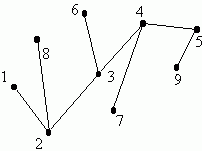
(Note: some texts require that you designate one node of a tree as the "root" node.) There are many conditions that turn out to be equivalent to the "connected and acyclic" requirement. The following are each equivalent conditions for a graph G. This means that any of them could have been used as the definition of tree. Check that each of them holds in the example tree drawn above.
Multigraphs
In a multigraph, we allow potentially more than one edge between two vertices. This would be useful if the nodes represents cities, and the edges represent daily plane flights between them. If there were 4 flights from Denver to Chicago each day, we could represent this with 4 edges. If the nodes represent locations on a map and the edges represent roads between them, then if there are two or more different roads connecting two points, we could represent that with multiple edges between them. If the nodes represent atoms and the edges represent chemical bonds, then we can represent a double or triple bonds with two or 3 edges. Here's an example of a multi-graph.

(Note: graph theory can be used to help solve the game "Instant insanity", in which you try to arrange 4 multi-colored cubes in a column of 4 so that each color appears on each side of the column. The above multi-graph is part of the solution.)
Degrees of vertices
In a graph or a multi-graph, the degree of a vertex v (written deg(v)) is the number of edge ends at that vertex. For example, in the multi-graph above, deg(W) = 3, deg(B)=5, deg(R) = 7, and deg(Y) = 9.
The Königsberg bridge problem
Leonard Euler began the study of graph theory. He was inspired to begin the study by the Königsberg bridge problem. Legend has it that in the early 1700's it was a popular weekend pasttime in Königsberg (now Kaliningrad) to stroll around the city trying to find a path that crossed exactly once each one of the 7 bridges over the Pregel River, and then returned to the starting point. Here's a web page shows a map of Königsberg from that era: Königsberg's bridges. Euler invented graph theory in order to solve this problem, and he succeeded in solving it in 1736. He modeled the bridges with edges in a multigraph, the nodes representing the regions on the city. Here is a multigraph that represents the layout of the cities bridges:
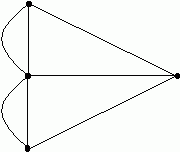
Euler paths and Euler circuits
An Euler path is a path in a graph that traverses each edge exactly once. An Euler circuit traverses each edge exactly once and ends at the vertex at which that it started. The Königsberg bridge problem asks you to find an Euler circuit. Can you find a solution? It's similar to a kid's puzzle that asks you to draw this picture of a house without lifting your pencil:

This time the problem is to find an Euler path. When does such a path or circuit exist, and when doesn't it? Euler answered this question with the following theorem.
Theorem on Euler paths An Euler path exists in a connected graph if and only if there are either no vertices of odd degree, or exactly two vertices of odd degree. In the case of no vertices of odd degree, then the path may start at any node, and will end where it started (giving an Euler circuit). In the case of two nodes of odd degree, the path must start at one of them and will end at the other.
Thus, there is a solution to the house picture, and every solution in the house picture must start and end at the bottom two nodes. In the other hand, the Königsberg bridge problem has no solution.
There is an algorithm for constructing an Euler circuit (or Euler path), if it exists. The procedure is recursive.


